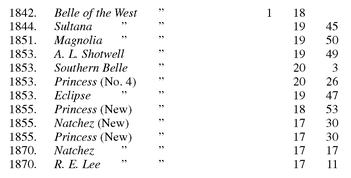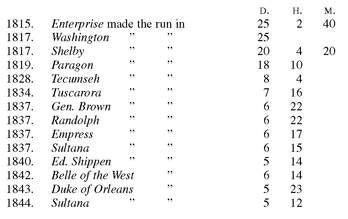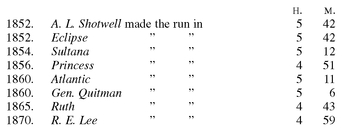Life on The Mississippi (19 page)
Read Life on The Mississippi Online
Authors: Mark Twain

If the boat was known to make her best speed when drawing five and a half feet forward and five feet aft, she was carefully loaded to that exact figure—she wouldn’t enter a dose of homeopathic pills on her manifest after that. Hardly any passengers were taken, because they not only add weight but they never will “trim boat.” They always run to the side when there is anything to see, whereas a conscientious and experienced steamboatman would stick to the center of the boat and part his hair in the middle with a spirit level.
No way-freights and no way-passengers were allowed, for the racers would stop only at the largest towns, and then it would be only “touch and go.” Coal flats and wood flats were contracted for beforehand, and these were kept ready to hitch onto the flying steamers at a moment’s warning. Double crews were carried, so that all work could be quickly done.
The chosen date being come, and all things in readiness, the two great steamers back into the stream, and lie there jockeying a moment, and apparently watching each other’s slightest movement, like sentient creatures; flags drooping, the pent steam shrieking through safety valves, the black smoke rolling and tumbling from the chimneys and darkening all the air. People, people everywhere; the shores, the housetops, the steamboats, the ships, are packed with them, and you know that the borders of the broad Mississippi are going to be fringed with humanity thence northward twelve hundred miles, to welcome these racers.
Presently tall columns of steam burst from the ’scape pipes of both steamers, two guns boom a good-bye, two red-shirted heroes mounted on capstans wave their small flags above the massed crews on the forecastles, two plaintive solos linger on the air a few waiting seconds, two mighty choruses burst forth—and here they come! Brass bands bray “Hail Columbia,” huzza after huzza thunders from the shores, and the stately creatures go whistling by like the wind.
Those boats will never halt a moment between New Orleans and St. Louis, except for a second or two at large towns, or to hitch thirty-cord wood boats alongside. You should be onboard when they take a couple of those wood boats in tow and turn a swarm of men into each; by the time you have wiped your glasses and put them on, you will be wondering what has become of that wood.
Two nicely matched steamers will stay in sight of each other day after day. They might even stay side by side, but for the fact that pilots are not all alike, and the smartest pilots will win the race. If one of the boats has a “lightning” pilot, whose “partner” is a trifle his inferior, you can tell which one is on watch by noting whether that boat has gained ground or lost some during each four-hour stretch. The shrewdest pilot can delay a boat if he has not a fine genius for steering. Steering is a very high art. One must not keep a rudder dragging across a boat’s stern if he wants to get up the river fast.
There is a great difference in boats, of course. For a long time I was on a boat that was so slow we used to forget what year it was we left port in. But of course this was at rare intervals. Ferryboats used to lose valuable trips because their passengers grew old and died, waiting for us to get by. This was at still rarer intervals. I had the documents for these occurrences, but through carelessness they have been mislaid. This boat, the
John J. Roe
, was so slow that when she finally sunk in Madrid Bend, it was five years before the owners heard of it. That was always a confusing fact to me, but it is according to the record, anyway. She was dismally slow; still, we often had pretty exciting times racing with islands, and rafts, and such things. One trip, however, we did rather well. We went to St. Louis in sixteen days. But even at this rattling gait I think we changed watches three times in Fort Adams reach, which is five miles long. A “reach” is a piece of straight river, and of course the current drives through such a place in a pretty lively way.
John J. Roe
, was so slow that when she finally sunk in Madrid Bend, it was five years before the owners heard of it. That was always a confusing fact to me, but it is according to the record, anyway. She was dismally slow; still, we often had pretty exciting times racing with islands, and rafts, and such things. One trip, however, we did rather well. We went to St. Louis in sixteen days. But even at this rattling gait I think we changed watches three times in Fort Adams reach, which is five miles long. A “reach” is a piece of straight river, and of course the current drives through such a place in a pretty lively way.
That trip we went to Grand Gulf, from New Orleans, in four days (three hundred and forty miles); the
Eclipse
and
Shotwell
did it in one. We were nine days out, in the chute of 63 (seven hundred miles); the
Eclipse
and
Shotwell
went there in two days. Something over a generation ago, a boat called the
J. M. White
went from New Orleans to Cairo in three days, six hours, and forty-four minutes. In 1853 the
Eclipse
made the same trip in three days, three hours, and twenty minutes.
12
In 1870 the
R. E. Lee
did it in three days and
one
hour. This last is called the fastest trip on record. I will try to show that it was not. For this reason: the distance between New Orleans and Cairo, when the
J. M. White
ran it, was about eleven hundred and six miles; consequently her average speed was a trifle over fourteen miles per hour. In the
Eclipse
’s day the distance between the two ports had become reduced to one thousand and eighty miles; consequently her average speed was a shade under fourteen and three-eighths miles per hour. In the
R. E. Lee
’s time the distance had diminished to about one thousand and thirty miles; consequently her average was about fourteen and one-eighth miles per hour. Therefore the
Eclipse
’s was conspicuously the fastest time that has ever been made.
Eclipse
and
Shotwell
did it in one. We were nine days out, in the chute of 63 (seven hundred miles); the
Eclipse
and
Shotwell
went there in two days. Something over a generation ago, a boat called the
J. M. White
went from New Orleans to Cairo in three days, six hours, and forty-four minutes. In 1853 the
Eclipse
made the same trip in three days, three hours, and twenty minutes.
12
In 1870 the
R. E. Lee
did it in three days and
one
hour. This last is called the fastest trip on record. I will try to show that it was not. For this reason: the distance between New Orleans and Cairo, when the
J. M. White
ran it, was about eleven hundred and six miles; consequently her average speed was a trifle over fourteen miles per hour. In the
Eclipse
’s day the distance between the two ports had become reduced to one thousand and eighty miles; consequently her average speed was a shade under fourteen and three-eighths miles per hour. In the
R. E. Lee
’s time the distance had diminished to about one thousand and thirty miles; consequently her average was about fourteen and one-eighth miles per hour. Therefore the
Eclipse
’s was conspicuously the fastest time that has ever been made.
THE RECORD OF SOME FAMOUS TRIPS.
[
From Commodore Rollingpin’s Almanac
.]
FAST TIME ON THE WESTERN WATERS.
[
From Commodore Rollingpin’s Almanac
.]
FAST TIME ON THE WESTERN WATERS.
FROM NEW ORLEANS TO NATCHEZ—268 MILES.


FROM NEW ORLEANS TO CAIRO—1,024 MILES.

FROM NEW ORLEANS TO LOUISVILLE—1,440 MILES.


FROM NEW ORLEANS TO DONALDSONVILLE—78 MILES.

FROM NEW ORLEANS TO ST. LOUIS—1,218 MILES.

FROM LOUISVILLE TO CINCINNATI—141 MILES.

FROM LOUISVILLE TO ST. LOUIS—750 MILES.

Other books
The Friar of Carcassonne by Stephen O'Shea
Snow in Love by Ray, Claire
The Marriage Pact (1) by M. J. Pullen
Give Me Love by McCarthy, Kate
Peaches and Scream (Georgia Peach Mystery, A) by Susan Furlong
The Stars of Summer by Tara Dairman
Bang The Drum Slowly by Mark Harris
The Girl With Death Breath and Other Naughty Stories for Good Boys and Girls by Christopher Milne
The Rocketeer by Peter David